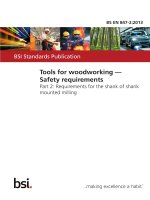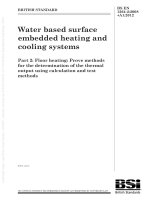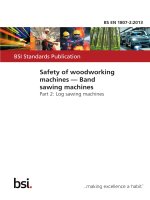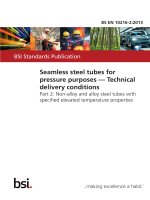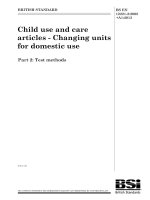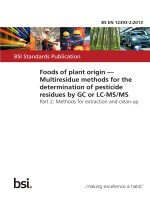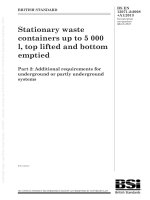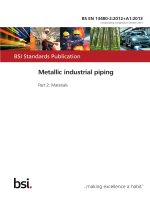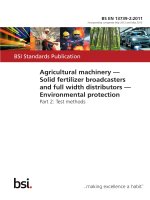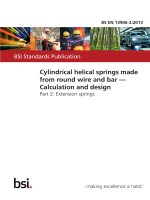Bsi bs en 50290 2 25 2013
Bạn đang xem bản rút gọn của tài liệu. Xem và tải ngay bản đầy đủ của tài liệu tại đây (913.86 KB, 14 trang )
BS EN 50290-2-25:2013
BSI Standards Publication
Communication cables Part 2-25: Common design rules and
construction — Polypropylene insulation
compounds
BS EN 50290-2-25:2013
BRITISH STANDARD
National foreword
This British Standard is the UK implementation of EN
50290-2-25:2013. It supersedes BS EN 50290-2-25:2002 which is
withdrawn.
The UK participation in its preparation was entrusted to Technical
Committee EPL/46, Cables, wires and waveguides, radio frequency
connectors and accessories for communication and signalling.
A list of organizations represented on this committee can be
obtained on request to its secretary.
This publication does not purport to include all the necessary
provisions of a contract. Users are responsible for its correct
application.
© The British Standards Institution 2013. Published by BSI Standards
Limited 2013
ISBN 978 0 580 82664 1
ICS 29.035.20; 33.120.10
Compliance with a British Standard cannot confer immunity from
legal obligations.
This British Standard was published under the authority of the
Standards Policy and Strategy Committee on 30 November 2013.
Amendments issued since publication
Date
Text affected
BS EN 50290-2-25:2013
EN 50290-2-25
EUROPEAN STANDARD
NORME EUROPÉENNE
EUROPÄISCHE NORM
November 2013
ICS 29.035.20; 33.120.10
Supersedes EN 50290-2-25:2002
English version
Communication cables Part 2-25: Common design rules and construction Polypropylene insulation compounds
Câbles de communication Partie 2-25: Règles de conception
communes et construction Polypropylène pour enveloppes isolantes
Kommunikationskabel Teil 2-25: Gemeinsame Regeln für
Entwicklung und Konstruktion Polypropylen-Isoliermischungen
This European Standard was approved by CENELEC on 2013-09-16. CENELEC members are bound to
comply with the CEN/CENELEC Internal Regulations which stipulate the conditions for giving this European
Standard the status of a national standard without any alteration.
Up-to-date lists and bibliographical references concerning such national standards may be obtained on
application to the CEN-CENELEC Management Centre or to any CENELEC member.
This European Standard exists in three official versions (English, French, German). A version in any other
language made by translation under the responsibility of a CENELEC member into its own language and
notified to the CEN-CENELEC Management Centre has the same status as the official versions.
CENELEC members are the national electrotechnical committees of Austria, Belgium, Bulgaria, Croatia,
Cyprus, the Czech Republic, Denmark, Estonia, Finland, Former Yugoslav Republic of Macedonia, France,
Germany, Greece, Hungary, Iceland, Ireland, Italy, Latvia, Lithuania, Luxembourg, Malta, the Netherlands,
Norway, Poland, Portugal, Romania, Slovakia, Slovenia, Spain, Sweden, Switzerland, Turkey and the United
Kingdom.
CENELEC
European Committee for Electrotechnical Standardization
Comité Européen de Normalisation Electrotechnique
Europäisches Komitee für Elektrotechnische Normung
CEN-CENELEC Management Centre: Avenue Marnix 17, B - 1000 Brussels
© 2013 CENELEC -
All rights of exploitation in any form and by any means reserved worldwide for CENELEC members.
Ref. No. EN 50290-2-25:2013 E
BS EN 50290-2-25:2013
EN 50290-2-25:2013
-2-
Contents
Foreword ................................................................................................................................................................ 3
1
Scope ............................................................................................................................................................... 5
2
Normative references ..................................................................................................................................... 5
3
Compound test requirements ....................................................................................................................... 6
4
Cable test requirements ................................................................................................................................. 6
5
Health, Safety and Environmental Regulations ........................................................................................... 6
Bibliography ........................................................................................................................................................... 9
BS EN 50290-2-25:2013
-3-
EN 50290-2-25:2013
Foreword
This document (EN 50290-2-25:2013) was prepared by CLC/TC 46X "Communication cables".
The following dates are fixed:
•
•
latest date by which this document has
to be implemented at national level by
publication of an identical national
standard or by endorsement
latest date by which the national
standards conflicting with this
document have to be withdrawn
(dop)
2014-09-16
(dow)
2016-09-16
This document supersedes EN 50290-2-25:2002.
EN 50290-2-25:2013 includes the following significant technical changes with respect to EN 50290-2-25:2002:
−
The document has been entirely restructured.
−
The main change is the introduction of the new Table 1 for the test to be performed on granules.
This document should be read in conjunction with EN 50290-2-20, the product standard EN 50288 (all parts) and
other applicable product standards.
Attention is drawn to the possibility that some of the elements of this document may be the subject of patent
rights. CENELEC [and/or CEN] shall not be held responsible for identifying any or all such patent rights.
This document has been prepared under a mandate given to CENELEC by the European Commission and the
European Free Trade Association, and supports essential requirements of EU Directive(s).
This standard covers the Principle Elements of the Safety Objectives for Electrical Equipment Designed for Use
within Certain Voltage Limits (LVD - 2006/95/EC).
EN 50290-2, Communication cables, is divided into the following sub-parts:
−
Part 2-1: Common design rules and construction;
−
Part 2-2: Common design rules and construction Polyethylene insulation for multi element metallic data
cables for indoor application [currently at Enquiry stage];
−
Part 2-3: Common design rules and construction Polyethylene insulation for coaxial cables [currently at
Enquiry stage];
−
Part 2-4: Common design rules and construction Polypropylene insulation for coaxial cables [currently at
Enquiry stage];
−
Part 2-20: Common design rules and construction General;
−
Part 2-21: Common design rules and construction PVC insulation compounds;
−
Part 2-22: Common design rules and construction PVC sheathing compounds;
−
Part 2-23: Common design rules and construction PE insulation;
−
Part 2-24: Common design rules and construction PE sheathing;
BS EN 50290-2-25:2013
EN 50290-2-25:2013
-4-
−
Part 2-25: Common design rules and construction Polypropylene insulation for compounds [the present
document];
−
Part 2-26: Common design rules and construction Halogen free flame retardant insulation compounds;
−
Part 2-27: Common design rules and construction Halogen free flame retardant thermoplastic sheathing
compounds;
−
Part 2-28: Common design rules and construction Filling compounds for filled cables;
−
Part 2-29: Common design rules and construction Cross-linked PE insulation compounds;
−
Part 2-30: Common design rules and construction Poly(tetrafluoroethylene-hexafluoropropylene) (FEP)
insulation and sheathing;
−
Part 2-32: Common design rules and construction Halogen free insulation compounds for flame retardant
and fire resistant cables [currently at Enquiry stage].
_________
BS EN 50290-2-25:2013
-5-
EN 50290-2-25:2013
1 Scope
This European Standard gives specific requirements for PP compounds to be used for multi-element metallic
data cables for indoor application. Type 1 is typically a copolymer with better low temperature properties. Type 2
is typically a homopolymer with superior hardness giving better crush resistance.
Using compound and type test data as outlined in this standard, the compound supplier will have sufficient data
to demonstrate compliance and warrant that the material is suitable for the specified application.
2 Normative references
The following documents, in whole or in part, are normatively referenced in this document and are indispensable
for its application. For dated references, only the edition cited applies. For undated references, the latest edition
of the referenced document (including any amendments) applies.
EN 50267-2-2, Common test methods for cables under fire conditions Tests on gases evolved during
combustion of materials from cables Part 2-2: Procedures Determination of degree of acidity of gases for
materials by measuring pH and conductivity
EN 50290-2-20, Communication cables Part 2-20: Common design rules and construction General
EN 60216 (all parts), Electrical insulating materials Thermal endurance properties (IEC 60216, all parts)
EN 60811-401, Electric and optical fibre cables Test methods for non-metallic materials Part 401:
Miscellaneous tests Thermal ageing methods Ageing in an air oven (IEC 60811-401)
EN 60811-501, Electric and optical fibre cables Test methods for non-metallic materials Part 501:
Mechanical tests Tests for determining the mechanical properties of insulating and sheathing compounds
(IEC 60811-501)
EN 60811-502, Electric and optical fibre cables Test methods for non-metallic materials Part 502:
Mechanical tests - Shrinkage test for insulations (IEC 60811-502)
EN 60811-504, Electric and optical fibre cables Test methods for non-metallic materials Part 504:
Mechanical tests Bending tests at low temperature for insulation and sheaths (IEC 60811-504)
EN 60811-510, Electric and optical fibre cables Test methods for non-metallic materials Part 510:
Mechanical tests Methods specific to polyethylene and polypropylene compounds Wrapping test after
thermal ageing in air (IEC 60811-510)
EN ISO 179-1, Plastics Determination of Charpy impact properties Part 1: Non-instrumented impact test
(ISO 179-1)
EN ISO 527 (all parts), Plastics Determination of tensile properties (ISO 527, all parts)
EN ISO 868, Plastics and ebonite Determination of indentation hardness by means of a durometer (Shore
hardness) (ISO 868)
EN ISO 1133 (all parts), Plastics Determination of the melt mass-flow rate (MFR) and melt volume-flow rate
(MVR) of thermoplastics (ISO 1133, all parts)
EN ISO 1183 (all parts), Plastics Methods for determining the density of non-cellular plastics (ISO 1183, all
parts)
BS EN 50290-2-25:2013
EN 50290-2-25:2013
-6-
EN ISO 5659-2, Plastics Smoke generation Part 2: Determination of optical density by a single-chamber
test (ISO 5659-2)
EN ISO 11357-6, Plastics Differential scanning calorimetry (DSC) Part 6: Determination of oxidation
induction time (isothermal OIT) and oxidation induction temperature (dynamic OIT) (ISO 11357-6)
IEC 60250, Recommended methods for the determination of the permittivity and dielectric dissipation factor of
electrical insulating materials at power, audio and radio frequencies including metre wavelengths
ASTM D4565 (section 19), Standard Test Methods for Physical and Environmental Performance Properties of
Insulations and Jackets for Telecommunications Wire and Cable; Section 19: Insulation adhesion
3 Compound test requirements
The tests are to be carried out on granules or moulded plaques produced from granules of compound. This data
shall be provided by the compound supplier. For compounds intended for foam application the properties shall
be measured on unexpanded material. Relevant test methods, requirements and limits shall be included in any
supply specification of the compound.
Specific requirements are shown in Tables 1 to 3. In the case of special applications, additional requirements
could be specified.
4 Cable test requirements
The anticipated performance assumes standard cable design and conventional process technology and is
specified (Table 4). Using type test data the compound supplier is expected to demonstrate compliance and
warrant that the material is suitable for the specified application.
In the case of special applications, additional requirements could be specified.
5 Health, Safety and Environmental Regulations
The compounds are subject to Health, Safety and Environmental requirements as defined in EN 50290-2-20.
Any deviations or compliance failures shall be identified by the compound supplier.
BS EN 50290-2-25:2013
-7-
EN 50290-2-25:2013
Table 1 Insulation compound Physical properties of granules
Characteristics
a
Test method
Unit
Solid
Type 1
EN ISO 1183
(all parts)
b
1
Density
2
Melt flow index (230°C/2,16 kg)
EN ISO 1133
(all parts)
3
Hardness Shore D (1 s)
EN ISO 868
4
Low Temperature Brittleness (Charpy EN ISO 179-1
unnotched impact strength, -20°C)
5
Mechanical characteristics
5.1
Tensile strength- median, min.
5.2
Elongation at break- median, min.
6
Oxidative Induction Time (200 °C)
c
a
g/cm
3
Foam
d
Type 2
≤ 0,915
≤ 0,915
≤ 0,915
g/10
min
To be
specified
To be
specified
To be
specified
[-]
>62
>67
>62
KJ/m²
>25
>10
>25
MPa
25
25
25
%
na
na
na
min
>15
>15
>15
EN ISO 527
(all parts)
EN ISO 11357-6
All values of Table 1 shall be provided by the compound supplier; see Clause 3.
Tolerance for the nominal value of a specific compound is +/- 0,003 g/cm³.
Tolerance for the nominal value of a specific compound is +/- 25%.
Applicable also to Foam skin.
b
c
d
Table 2 Insulation compound Dielectric properties
Characteristics
1
2
a
b
c
a
a
Dielectric constant at 1 MHz
b
Dissipation factor at 1MHz
Unit
Solid
Foam
IEC 60250
[-]
<2,25
<2,25
IEC 60250
[-]
<0,000 2
<0,000 3
All values of Table 2 shall be provided by the compound supplier; see Clause 3.
Median value to be specified by supplier. Specification limits +/- 0,02.
Applicable also to Foam skin.
Table 3 Insulation compound Combustion properties
Characteristics
a
Test method
EN 50267-2-2
1
Corrosivity
pH
Conductivity
Smoke opacity
Dmax (Flaming Mode)
Dmax (Non Flaming Mode)
EN ISO 5659-2
2
3
Toxicity
a
b
c
c
Test method
b
Unit
Solid
Foam
[-]
μS/cm
>4,3
<10
>4,3
<10
<80
<120
<80
<120
tbd
tbd
Under
consideration
All values of Table 3 shall be provided by the compound supplier; see Clause 3.
To be performed if specified in the relevant product standard.
Applicable also to Foam skin.
c
BS EN 50290-2-25:2013
EN 50290-2-25:2013
-8-
Table 4 Wire insulation properties
Characteristics
Test
Unit
method
1
Maximum rated temperature of
cable for which the compound can
be used
2
Mechanical characteristics
b
EN 60216
a
(all parts)
Tensile strength- median,min.
Elongation at break- median,min.
3
Bending test at low temperature
4.2
Thermal ageing
- temperature
- duration
EN 60811-401
b
Elongation at break after ageing
Result to be obtained- median,min.
Wrapping after ageing
c
EN 60811-501
b
c
d
Type 2
°C
90
90
90
MPa
%
15
300
15
300
5
125
°C
-20 ± 2
No crack
-15 ± 2
No crack
-30 ± 2
No crack
°C
h
100 ± 2
10 x 24
100 ± 2
10 x 24
100 ± 2
10 x 24
%
300
300
125
°C
h
100 ± 2
14 x 24
No crack
100 ± 2
14 x 24
No crack
100 ± 2
14 x 24
No crack
°C
h
%
130 ± 2
1
5
130 ± 2
1
5
130 ± 2
1
5
N
>5
>5
>5
EN 60811-510
- Ageing temperature
- duration
Result to be obtained
a
Type 1
EN 60811-504
Test temperature
b
Result to be obtained
4.1
Foam
EN 60811-501
2.1
2.2
4
Solid
5
Shrinkage
- temperature
- duration
Result to be obtained- max.
EN 60811-502
6
Strip force
ASTM D4565
(section 19)
Any procedure based on the Arrhenius principals which can predict 20 000 h life expectancy at the indicated
temperature.
If elongation at break cannot be done(i.e. if the insulation cannot be removed from the conductor without damage),
wrapping test according to EN 60811-510 shall be performed.
Stress whitening occurring as a result of the wrapping shall not be interpreted as a crack.
Conductor skin permitted if needed to achieve required result.
d
BS EN 50290-2-25:2013
-9-
EN 50290-2-25:2013
Bibliography
[1]
EN 50288 (all parts), Multi-element metallic cables used in analogue and digital communication and
control
[2]
ISO 974, Plastics Determination of the brittleness temperature by impact
This page deliberately left blank
This page deliberately left blank
NO COPYING WITHOUT BSI PERMISSION EXCEPT AS PERMITTED BY COPYRIGHT LAW
British Standards Institution (BSI)
BSI is the national body responsible for preparing British Standards and other
standards-related publications, information and services.
BSI is incorporated by Royal Charter. British Standards and other standardization
products are published by BSI Standards Limited.
About us
Revisions
We bring together business, industry, government, consumers, innovators
and others to shape their combined experience and expertise into standards
-based solutions.
Our British Standards and other publications are updated by amendment or revision.
The knowledge embodied in our standards has been carefully assembled in
a dependable format and refined through our open consultation process.
Organizations of all sizes and across all sectors choose standards to help
them achieve their goals.
Information on standards
We can provide you with the knowledge that your organization needs
to succeed. Find out more about British Standards by visiting our website at
bsigroup.com/standards or contacting our Customer Services team or
Knowledge Centre.
Buying standards
You can buy and download PDF versions of BSI publications, including British
and adopted European and international standards, through our website at
bsigroup.com/shop, where hard copies can also be purchased.
If you need international and foreign standards from other Standards Development
Organizations, hard copies can be ordered from our Customer Services team.
Subscriptions
Our range of subscription services are designed to make using standards
easier for you. For further information on our subscription products go to
bsigroup.com/subscriptions.
With British Standards Online (BSOL) you’ll have instant access to over 55,000
British and adopted European and international standards from your desktop.
It’s available 24/7 and is refreshed daily so you’ll always be up to date.
You can keep in touch with standards developments and receive substantial
discounts on the purchase price of standards, both in single copy and subscription
format, by becoming a BSI Subscribing Member.
PLUS is an updating service exclusive to BSI Subscribing Members. You will
automatically receive the latest hard copy of your standards when they’re
revised or replaced.
To find out more about becoming a BSI Subscribing Member and the benefits
of membership, please visit bsigroup.com/shop.
With a Multi-User Network Licence (MUNL) you are able to host standards
publications on your intranet. Licences can cover as few or as many users as you
wish. With updates supplied as soon as they’re available, you can be sure your
documentation is current. For further information, email
BSI Group Headquarters
389 Chiswick High Road London W4 4AL UK
We continually improve the quality of our products and services to benefit your
business. If you find an inaccuracy or ambiguity within a British Standard or other
BSI publication please inform the Knowledge Centre.
Copyright
All the data, software and documentation set out in all British Standards and
other BSI publications are the property of and copyrighted by BSI, or some person
or entity that owns copyright in the information used (such as the international
standardization bodies) and has formally licensed such information to BSI for
commercial publication and use. Except as permitted under the Copyright, Designs
and Patents Act 1988 no extract may be reproduced, stored in a retrieval system
or transmitted in any form or by any means – electronic, photocopying, recording
or otherwise – without prior written permission from BSI. Details and advice can
be obtained from the Copyright & Licensing Department.
Useful Contacts:
Customer Services
Tel: +44 845 086 9001
Email (orders):
Email (enquiries):
Subscriptions
Tel: +44 845 086 9001
Email:
Knowledge Centre
Tel: +44 20 8996 7004
Email:
Copyright & Licensing
Tel: +44 20 8996 7070
Email:
